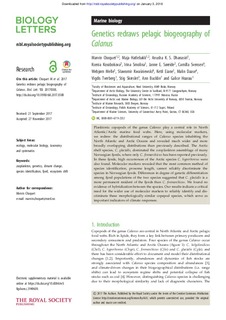Genetics redraws pelagic biogeography of Calanus
Choquet, Marvin Raoul Charles Roger Ren; Haltebakk, Maja; Dhanasiri, Anusha Krishanthi Shyama; Kosobokova, Ksenia N.; Smolina, Irina Vladimirovna; Søreide, Janne; Svensen, Camilla; Melle, Webjørn Raunsgård; Kwasniewski, Slawomir; Eiane, Ketil; Daase, Malin; Tverberg, Vigdis; Skreslet, Stig; Bucklin, Ann; Hoarau, Galice Guillaume
Peer reviewed, Journal article
Published version
Permanent lenke
http://hdl.handle.net/11250/2475543Utgivelsesdato
2017Metadata
Vis full innførselSamlinger
- Articles [3012]
- Publikasjoner fra CRIStin [3070]
Sammendrag
Planktonic copepods of the genus Calanus play a central role in North Atlantic/Arctic marine food webs. Here, using molecular markers, we redrew the distributional ranges of Calanus species inhabiting the North Atlantic and Arctic Oceans and revealed much wider and more broadly overlapping distributions than previously described. The Arctic shelf species, C. glacialis, dominated the zooplankton assemblage of many Norwegian fjords, where only C. finmarchicus has been reported previously. In these fjords, high occurrences of the Arctic species C. hyperboreus were also found. Molecular markers revealed that the most common method of species identification, prosome length, cannot reliably discriminate the species in Norwegian fjords. Differences in degree of genetic differentiation among fjord populations of the two species suggested that C. glacialis is a more permanent resident of the fjords than C. finmarchicus. We found no evidence of hybridization between the species. Our results indicate a critical need for the wider use of molecular markers to reliably identify and discriminate these morphologically similar copepod species, which serve as important indicators of climate responses.
